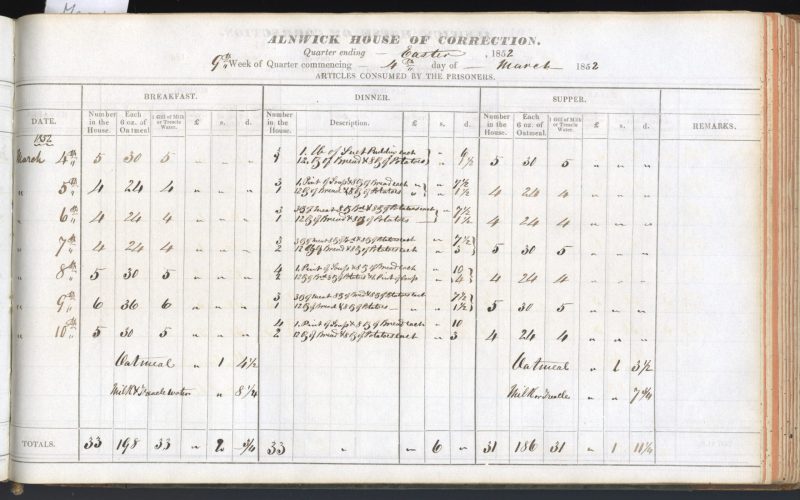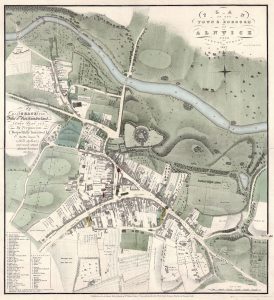Weekly meal planning with Alnwick House of Correction
DIETARY OF ALNWICK HOUSE OF CORRECTION, 4TH MARCH 1852, REFERENCE: NRO 304/53
ALNWICK HOUSE OF CORRECTION
Alnwick House of Correction was situated in Green Batt and was opened in 1807. Poor people were sent there if they refused to work. It also acted as a prison for criminals who had committed minor crimes and were sentenced to hard labour – normally breaking stones.
💡Do you think it was right to send poor people who refused to work, and criminals who had committed minor crimes to the House of Correction?
💡Do you think it was right to sentence the inmates to hard labour?
💡 Do you think hard labour would have caused the inmates to work up an appetite?
🌍 Can you find where the House of Correction would have been on a map of Alnwick?
THE FOOD
In 1853, 73 people were committed to this prison. The prisoners were all served the same food. The document notes the food eaten by the prisoners between 4th and 10th March 1852. Breakfast each day was oatmeal with either milk or treacle water. This was probably a form of porridge.
Dinner was a bit more varied depending on the day of the week. On Thursdays, there was suet pudding, bread and potatoes. On Mondays, Wednesdays and Fridays there was soup with bread and potatoes whilst on Tuesdays, Saturdays and Sundays a little bit of meat was served with more bread and potatoes. Supper was exactly the same as breakfast.
It cost 10 shillings to feed the prisoners that week, equivalent to about £40 today.
💡 Would you want to eat any of this food?
💡Do you think the inmates were served enough food?
💡What are macro nutrients and food groups? Can you work out the different types of food your body needs?
✏ Can you organise the inmates’ food into different food group and macro nutrient categories? Do you think they were getting enough variety?
✏Create a weekly food plan and shopping list for your household. Can you work out how much this would cost?
✏Imagine you’ve been given a £40 budget to feed your household for a week. Create a weekly meal plan and shopping list sticking to the budget. Is this achievable? Can you get enough food with enough variety?
SUET PUDDING

Hannah Glasse (1708-1770), daughter of Northumbrian landowner Isaac Allgood, was a cookbook author. In 1747 she published the cookery book The Art of Cookery Made Plain and Easy.
The book contains a recipe for suet pudding. Suet pudding is a boiled, steamed or baked pudding made with wheat flour and suet. It can be sweet or savoury and can either house a filling or can have ingredients such as fruit and nuts cooked into the mixture.
💡 What type of suet pudding do you think the inmates were served?
💡How does Hannah’s recipe sound, would you like to try her suet pudding?
💡Would you prefer a sweet or savoury suet pudding?
💡 How would you cook a pudding today? Would you still boil it for 2 hours? Did you know you can steam a pudding in the microwave in several minutes?
✏ Can you come up with ideas of what you would add to your suet pudding?
✏ Have a go at modernising and rewriting Hannah’s suet pudding recipe. Can you make it more appetising? Will you change how it’s cooked?
👩🍳Have a go at making your updated suet pudding recipe.



